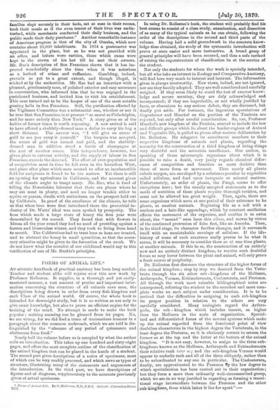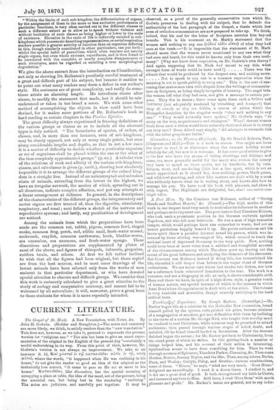FORMS OF ANIMAL LIFE.* Arz accurate handbook of practical anatomy
has been long needed. "Teacher and student alike will rejoice over this new work by Professor Rolleston. It supplies, in a thorough and yet easily- 'mastered manner, a vast amount of precise and important infor- mation concerning the structure of all animals save man, the -descriptions being drawn in order from every Sub-kingdom and each Class of the animal world. Of course, the whole book is intended for downright study, but it is so written as not only to give exact knowledge, but also to prove an efficient engine for the training of the mind. No attempt is made to make the book popular ; nothing amusing can be gleaned from its pages. No, we are wrong, for we did find a trace of unconscious humour in a paragraph about the common cockroach, which we are told is dis- tinguished by the "absence of any period of quiescence and -abstinence from food."
Nearly half the volume before us is occupied by what the author calls an introduction. This takes up one hundred and sixty-eight pages, and offers the most complete outline of the classification of the animal kingdom that can be placed in the hands of a student. The second part gives descriptions of a series of specimens, most of which can be very readily procured, and which serve as types of structure, illustrating many of the statements and arguments of the introduction. In the third part, we have descriptions of figures and of diagrams, supplementary to the accounts previously given of actual specimens.
* Form Animat Life. By G. Rolleaton, 31.1)„ F.R.S. Oxford: Clarendon Prose.
In using Dr. Rolleston's book, the student will probably find his best course to consist of a close study, examination, and dissection of as many of the typical animals as he can obtain, following the order of the descriptions in the second and third parts of the volume. Having laid a solid groundwork in the concrete know- ledge thus obtained, the study of the systematic introduction will prove at once easier and more instructive. A broad grasp of general principles will have been secured, and thus a safe method of raising the superstructure of classification be at the service of the student.
Not only the students for whom the work is specially intended, but all who take an interest in Zoology and Comparative Anatomy, will find here very much to interest and instruct. The information given is always trustworthy. New views, indeed, are not ignored, nor are they hastily adopted. They are well considered and carefully weighed. If they seem likely to stand the test of exacter know- ledge and severe scrutiny, they are duly acknowledged and incorporated; if they are improbable, or not wholly justified by facts, or obnoxious to any serious defect, they are discussed, but finally put aside. For instance, the ingenious speculations of Gegenbauer and Haeckel on the position of the Tunicata are rejected, but only after careful consideration. So, too, Professor Haeckel's new kingdom of the Protista, erected to include the low and difficult groups which lie about the border-regions of Animal and Vegetable life, is pulled to pieces after mature deliberation by Dr. Rolleston. He relegates its constituent members to their respective kingdoms of animals and plants, regarding the necessity for the construction of a third kingdom of living things very doubtful and the materials insufficient. Our author, in speaking of those microscopic organisms about which it is possible to raise a doubt, very justly regards chemical differ- ences of composition and function as more decisive than those of mere form or movement. Thus nearly all plants exhale oxygen, are enveloped by a substance peculiar to vegetables called cellulose, and feed upon inorganic or mineral matters. Unfortunately, an order of plants, the Fungi, seems to offer exceptions here ; but the usually accepted statements as to the mode of nutrition of these plants require thorough revision, and must not be allowed too great weight. Then, again, there are some organisms which seem at one period of their existence to be plants, at another animals. Beginning life as a cell with a nucleus and a hair-like appendage, which by constant oscillation effects the movement of the organism, and enables it to swim about, the " monad " soon loses this cilium, and moves by virtue of the continued protrusion of false feet, like an Amoeba. Then, in its third stage, its character further changes, and it surrounds itself with an unmistakable envelope of cellulose. If the life- history of some of such creatures really proves to be what it seems, it will be necessary to consider them as at one time plants, at another animals. If this be so, the construction of an entirely new and an entirely distinct kingdom, to receive such doubtful forms as may hover between the plant and animal, will only prove a fresh source of perplexity.
Dr. Rolleston first discusses the structure of the higher forms of the animal kingdom ; step by step we descend from the Verte- brata through the six other sub - kingdoms of the Mollusca, Arthropoda, Vermes, Echinodermata, Coelenterata, and Protozoa. All through the work most valuable bibliographical notes are interspersed, referring the student to the soundest and most com- plete works on each subject under consideration. It is to be noticed that the difficulties in assigning to each sub-kingdom its proper position in relation to the others are very carefully considered. Many zoologists regard the Arthro- poda, the sub - kingdom which includes insects, as higher than the Mollusca in the scale of organization. Special- ized and differentiated forms of the several systems which make up the animal regarded from the functional point of view doubtless characterize in the highest degree the Vertebrate, in the least degree the Protozoa, so it is obviously correct to esteem the former as at the top and the latter at the bottom of the animal kingdom. " It is not easy, however, to assign to the three sub- kingdoms known as the Mollusc; Arthropods and Echinodermata their relative rank inter se ; and the sub-kingdom Vermes would appear to underlie each and all of the three obliquely, rather than to be subordinated to any one in particular. The Coelenterate, finally, are approximated to the Protozoa fry the low degree to which specialization has been carried out in their organization; but they form a more than ordinarily well-circumscribed group, which we are in no way justified in regarding as forming a transi- tional stage intermediate between the Protozoa and the other Bub-kingdoms, from which latter it lies far apart" :—
" Within the limits of each sub-kingdom the differentiation of organs, by the assignment of them to the more or less exclusive performance of particular functions, is very often carried out in the different classes to such a different extent as to allow us to speak without violence and without hesitation of such classes as being higher or lower in the scale of existence. Elevation in the scale of life is indirectly entailed in sub- kingdoms which possess air-breathing representatives, as aerial respiration renders possible a greater activity of function than an organism differing in this, though similarly constituted in other particulars, can put forth ; whilst the special habit of parasitism, which often renders not merely single organs, but even whole systems, superfluous, and is then found to be correlated with the complete or nearly complete disappearance of such structures, must be regarded as entailing a true morphological degradation."
We give the above extract from the introduction on Classification, not only as showing Dr. Rolleston's peculiarly careful treatment of a great and difficult part of his subject, but because it enables us to point out what many readers may deem a defect in our author's style. His sentences are of great complexity, and really do some- times attain an alarming length. He introduces clause after clause, to modify the statement first made, lest it should be mis- understood or taken in too broad a sense. We wish some other method of accomplishing the objects in view could have been
-devised, for it makes some portions of Dr. Rolleston's book as hard reading as certain chapters in the Pauline Epistles.
The great difficulty always experienced in framing definitions of the various groups or classes so as to include all the aberrant types is duly noticed. " The boundaries of species, of orders, of -classes, and, in more than one instance, even of sub-kingdoms, may be closely opposed, not only at many single points, but even along considerable lengths and depths, so that in not a few cases it is a matter of difficulty to decide whether a particular organism or set of organisms shall be placed within the one or the other of the thus complexly approximated groups." (p. xx.) A tabular view of the relations of rank and affinity of the various sub-kingdoms, -classes, and sub-classes is given (p. xxvii.), showing how absolutely impossible it is to arrange the different groups of the animal king- dom in a straight line. Instead of an uninterrupted and unbroken chain of animals, extending from the lowest to the highest, we have an irregular network, the meshes of which, spreading out in all directions, indicate complex affinities, and put any attempts at
a linear arrangement at defiance. In general, in the descriptions
of the characteristics of the different groups, the integumentary and motor organs are first treated of, then the digestive, circulatory, respiratory, and renal ; next follows a sketch of the nervous and reproductive systems ; and lastly, any peculiarities of development are noticed.
Among the animals from which the preparations have been made are the common rat, rabbit, pigeon, common fowl, ringed snake, common frog, perch, cod, edible snail, fresh-water mussel, -cockroach, crayfish, common earthworm, leech, bladder-worm, -sea cucumber, sea anemone, and fresh-water sponge. These -dissections and preparations are supplemented by plates of most of the above, and figures of rhizopods, infusoria, gregarina, sotifera tmnia, and others. At first we felt rather inclined to wish that all the figures had been original, but those copied are from the best sources, and in most cases drawings of the lowest animals have been selected only from the works of men eminent in that particular department, or who have devoted special attention to obscure and difficult groups. We consider that this work is eminently calculated to give a great stimulus to the study of zoology and comparative anatomy, and cannot fail to be welcomed by all naturalists ; it will, moreover, prove a great boon to those students for whom it is more especially intended.































 Previous page
Previous page